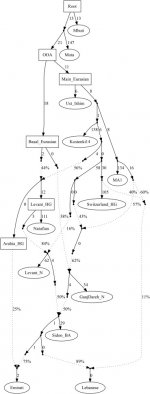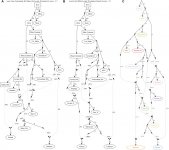real expert
Regular Member
- Messages
- 795
- Reaction score
- 455
- Points
- 63
Highlights
• Middle Easterners do not have ancestry from an early out-of-Africa expansion
Summary
The Middle East region is important to understand human evolution and migrations but is underrepresented in genomic studies. Here, we generated 137 high-coverage physically phased genome sequences from eight Middle Eastern populations using linked-read sequencing. We found no genetic traces of early expansions out-of-Africa in present-day populations but found Arabians have elevated Basal Eurasian ancestry that dilutes their Neanderthal ancestry. Population sizes within the region started diverging 15–20 kya, when Levantines expanded while Arabians maintained smaller populations that derived ancestry from local hunter-gatherers. Arabians suffered a population bottleneck around the aridification of Arabia 6 kya, while Levantines had a distinct bottleneck overlapping the 4.2 kya aridification event. We found an association between movement and admixture of populations in the region and the spread of Semitic languages. Finally, we identify variants that show evidence of selection, including polygenic selection. Our results provide detailed insights into the genomic and selective histories of the Middle East.
https://www.cell.com/cell/fulltext/S0092-8674(21)00839-4


• Middle Easterners do not have ancestry from an early out-of-Africa expansion
- Basal Eurasian and African ancestry in Arabians deplete their Neanderthal ancestry
- Populations experienced bottlenecks overlapping aridification events
- Identification of recent single and polygenic signals of selection in Arabia
Summary
The Middle East region is important to understand human evolution and migrations but is underrepresented in genomic studies. Here, we generated 137 high-coverage physically phased genome sequences from eight Middle Eastern populations using linked-read sequencing. We found no genetic traces of early expansions out-of-Africa in present-day populations but found Arabians have elevated Basal Eurasian ancestry that dilutes their Neanderthal ancestry. Population sizes within the region started diverging 15–20 kya, when Levantines expanded while Arabians maintained smaller populations that derived ancestry from local hunter-gatherers. Arabians suffered a population bottleneck around the aridification of Arabia 6 kya, while Levantines had a distinct bottleneck overlapping the 4.2 kya aridification event. We found an association between movement and admixture of populations in the region and the spread of Semitic languages. Finally, we identify variants that show evidence of selection, including polygenic selection. Our results provide detailed insights into the genomic and selective histories of the Middle East.
We next tested whether we can model our populations as deriving ancestry from one of the sampled regional Bronze Age populations and found that the Middle Bronze Age population from Sidon (Sidon_BA) could be a source of ancestry for some modern Levantine and Arabian populations (Tables S3 and S4). Our phylogenetic modeling suggests that modern Levantines could have directly derived their ancestry from a Sidon_BA-related population; however, Arabians require additional ancestry from a Natufian-related population (Figures 3 and S3).
https://www.cell.com/cell/fulltext/S0092-8674(21)00839-4



